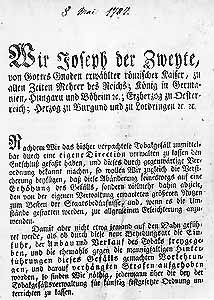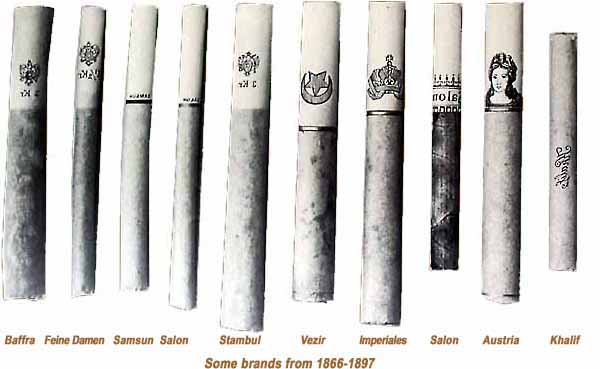About the history of smoking in Austria
and the Austrian tobacco monopoly
 1784: foundation of the Austrian monopolyIn 1784 the Austrian tobacco monopoly "Kaiserlich-Königliche Tabakregie" was founded by Emperer Joseph I (commemorated in 1934 by the brand Jubiläums-Zigaretten). The monopoly was very efficient but after the dead of emperor Joseph I in 1790, the new emperor Leopold wanted to decentralize it.
In the 18th century, only pipe tobacco was produced. Later the production of tobacco snuff started and in 1818, first Austrian cigars have been sold.
When French and English soldiers, who had fought alongside Turkish troops against Russia returned from the Crimean War, having experienced for the first time the Russian "papyrossi", a new smoking culture began to develop, namely cigarette smoking.
1865: Austrians first cigarette brand
As a result, in 1865, the Austrian tobacco monopoly produced its first cigarette , called Ordinäre Doppelzigarette, in two factories in Vienna, the Austrian capital and one factory in Hainburg (which still exists)(For the 100th anniversary, there was a special edition with pictures of old Austrian cig packs on it). It was sold for the price of 3 Kreuzer. The first cigarette brand in Austria was twice as long as the cigarettes of today and there were mouth pieces at both ends of the cigarette - so it was necessary to cut it through the middle before use. Although there have been used machines for its production, there was still lot of hand-made work to do.
In 1865 they sold 3 Millions and 1866 16 Millions pieces of this double cigarette.  In 1866 the Österreichische Tabakregie started with the production of "Feine Cigarretten" in Hainburg. In 1866 the Österreichische Tabakregie started with the production of "Feine Cigarretten" in Hainburg.
In 1871 the first small packets of 10 or 15 cigarettes, called "Kapseln" were produced.
1873: ten brands on the market
In 1873, the brand range was increased to this labels: Superfeine Cigarretten, Feinste, Bafra, Feine Damen, Feinste Damen, Feinste and Feine Trapezunter, Salon, Samsun, Stambul and Sultan. The oriental sounding names reflected the use of tobacco from the Orient.
 Especially for the presentation at the world exposition in Vienna was launched a new brand: Austria. In the same year, thre have been sold 64 brands of cigars in Austria. Especially for the presentation at the world exposition in Vienna was launched a new brand: Austria. In the same year, thre have been sold 64 brands of cigars in Austria.
In 1877 the k.u.k. Tabakregie launched 10 different test brands (Bektemis, Fitschirti, Gelepli, Ingies, Kiriziller, La Conquette, La Force, Mursal, Oksilar and Tschakirli for a period of 5 years to find out, which brands the smokers prefer. At first, it was hard to sale cigarettes.
1871: 17 million pieces
1876: 51 million pieces
1881: 81 million pieces
1882: a fast growing market for cigarettes
The break-through was in 1882, when there have been 123 millions cigarettes sold in the Austrian monarchy. Since this year, thee growth rate was 100 and later 200 milions a year - up to 3.000 million cigarettes, sold in 1900. The cigarette market was aimed primarily at the working class because the cigarettes were cheaper than cigars and its taste was stronger.
1880īs: the birth of two best-sellers
Two of the cheaper new labels, which came on the market since 1882, became best sellers: Sport (which was the renamed brand La Force, the winner of the test marketing before and as Sport for decades the most sold brand in Austria), and Drama. To manage the high demand especially for Drama, it was necessary to use production machines with motors, which started in 1883. It was a cheap brand in a quite cheap package. In 1892 Drama was the best-seller with 800 milion pieces a year and so the Österreichische k.u.k. Tabakregie invested in modern machines of Bonsack for the cigarette production. In 1896 modern machines in Hainburg produced 60.000 cigarettes a day. Because of the fact, that the Austrian monopoly would need twice as many machines, still a lot of the production, especially of Sport was made by female manual workers, whose products have been a higher quality than the machine-made cigarettes. In 1900 there have been almost 7.000 women working in the factories of the Austrian monarchy. Up to 1891, as machines replaced them, boys have been used as manual workers, to put the mouth pieces into the cigarette paper.
Other brands of this time, now long forgotten, were for example Fitschirti, Kiriziller, Vezir, Imperialesor Okzilar, Anubis, Jussuf, Azur and Sphinx.
19th century: luxury cigarettes, imported from Egypt
The more luxurious brands were produced in Cairo (for example Hanum). The Österreichische k.u.k. Tabakregie imported them directly and sold them in special shops.
In the 19th century, many new brands appeared which have been sold in Austria for a very long time.
Some other brands from the monarchy period survived the end of the monarchy, i.e.
- Amneris
- Khedive, here as tin and as a paper pack for 100 pieces.
- Memphis, which emerged in 1896 (since 2005 a new strong brand in a soft pack, Memphis 1896 reminds to it) and was named after Memphis in Egypt because of its oriental tobaccos is today - now named after Memphis, Tennessee and with an American blend - with its lot of variations still one of the best sold brands in Austria.
- Moeris
- Dames, here as tin, as paper pack and a less colorful paper back for 100 pieces.
1917: Highest selling rate in the monarchy
Finally, in 1908 the cigarette was the bestselling smoking product.
In 1917 Austria produced 1358 millions of cigarettes - the highest quantity ever during the monarchy period. This was in the third year of the World War I. Wars always have been a time of good sales rates, as well for the k.k. Tabakregie. In Styria, for example children have had to roll cigarettes for the soldiers on their way to the frontline. Because the cigarette, which only need a short time to consume (in contrast to pipes, cigars or cigarillos) was very suitable for a modern war with a high speed.
1918: The end of the k.k. Tabakregie
In 1918, with the end of the war, the Austrian monarchy was at the end. Austria shrinked from a big empire to a small country. With this, Austria lost as well its cigarette factories, like in Ljubljana (Slovenia), founded in 1871 (and closed in 2004 after Imperial Tobacco overtook Reemtsma), in Sarajevo (Bosnia) and in Rovinj (Croatia). The rest of the empire started now as the democratic republic of "Deutsch-Österreich".
Used literature/sources:
- Trost Ernst, Zur allgemeinen Erleichterung ... (Vienna 1984);
- 100 Jahre Tabakfabrik Linz 1850-1950 (Vienna 1950);
- 175 Jahre Österreichische Tabakregie (Vienna 1959)
- Fachliche Mittheilungen der österreichischen Tabakregie, 1. Jahrgang, 3. Heft (Nov. 1901)
- www.zigsam.at/R_Austria.htm (August 2005)
|